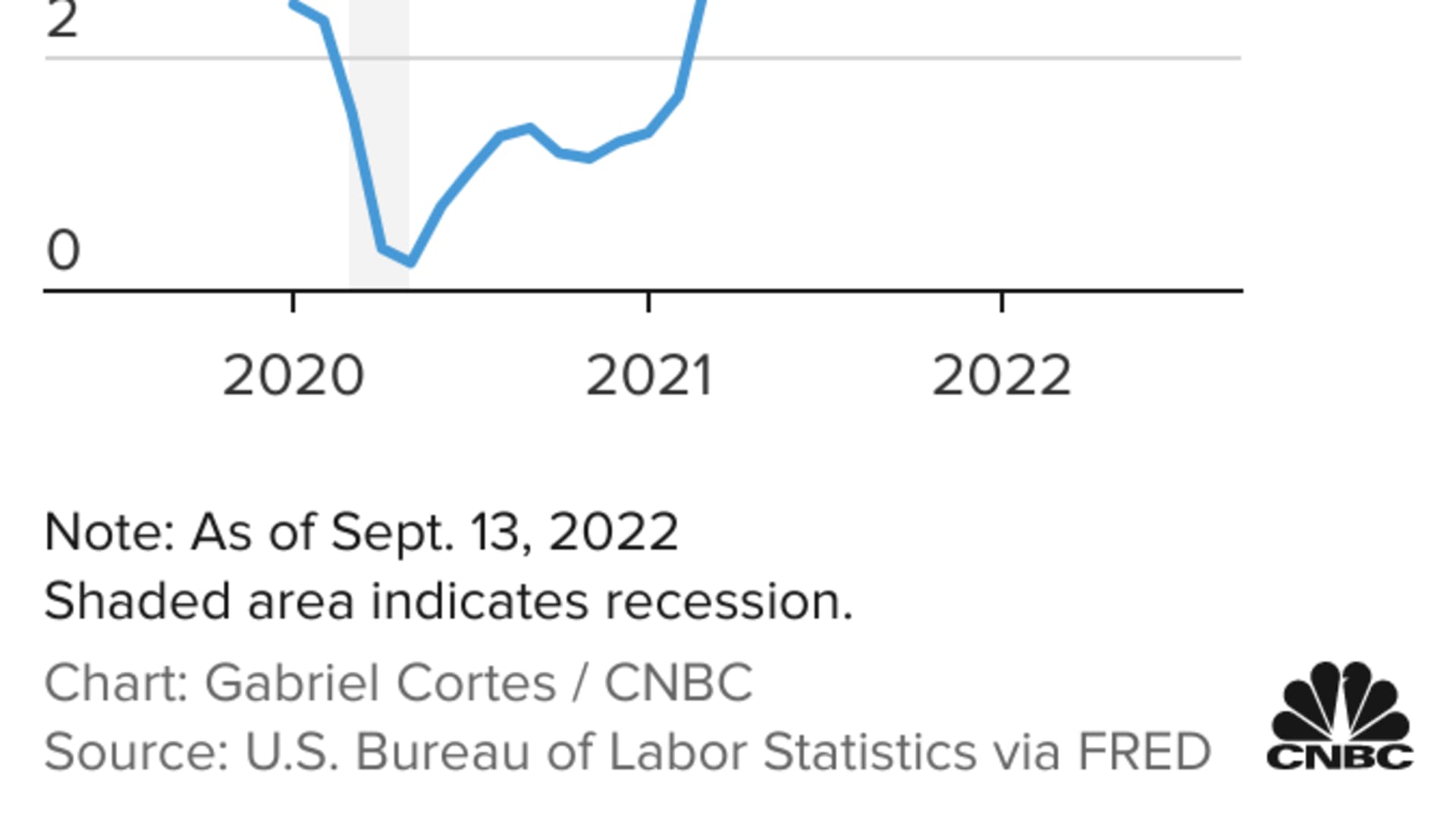
- The consumer price index increased 0.1% in August. Excluding food and energy, the inflation gauge rose 0.6%, both higher than expected.
- Costs were driven by increases in food, shelter and medical care services, offsetting a sharp decline in gasoline prices.
- Real average hourly earnings adjusted for inflation rose 0.2% for the month. However, they remained down 2.8% from a year ago.
Inflation rose more than expected in August as rising shelter and food costs offset a drop in gas prices, the Bureau of Labor Statistics reported Tuesday.
The consumer price index, which tracks a broad swath of goods and services, increased 0.1% for the month and 8.3% over the past year. Excluding volatile food and energy costs, CPI rose 0.6% from July and 6.3% from the same month in 2021.
Get top local stories in DFW delivered to you every morning. >Sign up for NBC DFW's News Headlines newsletter.
Economists had been expecting headline inflation to fall 0.1% and core to increase 0.3%, according to Dow Jones estimates. The respective year-over-year forecasts were for 8% and 6% gains.

Energy prices fell 5% for the month, led by a 10.6% slide in the gasoline index. However, those declines were offset by increases elsewhere.
Money Report
The food index increased 0.8% in August and shelter costs, which make up about one-third of the weighting in the CPI, jumped 0.7% and are up 6.2% from a year ago.
Medical care services also showed a big gain, rising 0.8% on the month and up 5.6% from August 2021. New vehicle prices also climbed, increasing 0.8% though used vehicles fell 0.1%.
Markets slumped after the news, with futures tied to the Dow Jones Industrial Average down nearly 350 points after being higher earlier.
"Today's CPI reading is a stark reminder of the long road we have until inflation is back down to earth," said Mike Loewengart, head of model portfolio construction for Morgan Stanley's Global Investment Office. "Wishful expectations that we are on a downward trajectory and the Fed will lay off the gas may have been a bit premature."
Treasury yields leaped higher, as the 2-year note, which is most closely tied to Federal Reserve interest rate moves, surged 0.13 percentage point to 3.704%.
Markets had been widely expecting the Fed to enact a 0.75 percentage point rate increase at its meeting next week. Following the CPI release, traders took the possibility of a half-point move completely off the table and even were pricing in a 10% chance of a full percentage point hike, according to CME Group data.
"They're watching for where inflation is coming from," said Quincy Krosby, chief equity strategist at LPL Financial. "It's very clear to them that it's food, it's transportation and it's rent. Rent keeps marching higher. That is the most stubborn of everything the Fed is fighting at this point."
The report presented conflicting sides of the inflation picture.
After peaking above $5 a gallon this summer, gasoline prices have pulled back sharply. However, the cost of living in other key areas such as food and shelter continues to push higher, raising concerns that inflation that had been concentrated is now beginning to spread.
Within the jump in food costs, bread prices rose 2.2% on the month and are up 16.2% from a year ago. Eggs surged another 2.9% and are up 39.8% for the 12-month period, and canned fruits increased 3.4% and 16.6%, respectively.
On the plus side, airline fares continued their recent decline, off 4.6% on the month though still 33.4% higher than a year ago.
There also was some good news for workers in the August report, as real average hourly earnings rose a seasonally adjusted 0.2% for the month. However, they remained down 2.8% from a year ago.
To combat the broad surge in the cost of living, the Federal Reserve has raised interest rates four times this year for a total of 2.25 percentage points. Tuesday's report was not expected to have great impact on the September meeting but rather through the end of the year and into 2023 as the central bank looks to tame inflation without tanking the economy.
The economy has broadly struggled in 2022 after posting its best year since 1984 last year, and inflation has played a major role. Gross domestic product contracted in each of the first two quarters, meeting a widely accepted definition of recession, and is on track to rise at just a 1.3% annualized pace in the third quarter, according to the Atlanta Fed.
The Federal Reserve is hoping to slow a labor market that has posted solid job gains through the year. Specifically, policymakers are concerned about a huge gap between job openings and available workers as labor force participation is stuck below its pre-pandemic levels. That has resulted in rising wages that have in turn put pressure on prices.






